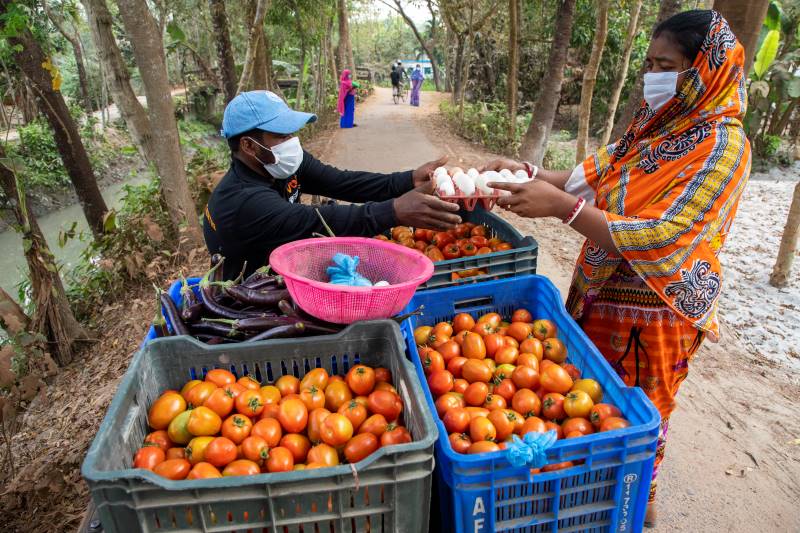Building farmers’ resilience with the Global Agriculture and Food Security Program

While countries continue to grapple with the impacts of COVID-19 disruptions, climate change and rising food and fuel prices, the war in Ukraine – a leading exporter of wheat, sunflower oil and other commodities – poses new threats to the world’s agrifood systems.
The Global Agriculture and Food Security Program (GAFSP), a multilateral financing instrument created in the wake of the 2007-2008 food price crisis, is “more relevant than ever,” said FAO Senior Economist, Benoist Veillerette.
Since 2010, GAFSP has amassed a portfolio of USD 1.7 billion in financing to fight poverty, hunger and malnutrition in the world’s poorest countries. GAFSP does this by funding agricultural projects along the value chain, offering a range of flexible tools such as grants and technical assistance to strengthen agriculture and food systems. FAO has helped design numerous GAFSP-funded projects, some implemented with FAO support, mainly in Africa, Asia and the Pacific.
“The GAFSP model, which matches investment in food and agriculture at country level with technical assistance, is really an effective one,” Veillerette said. “Our partnership with GAFSP is important.”
Kathryn Hollifield, Program Manager for GAFSP, echoed that sentiment.
“Partnership is a great word to describe the initiative,” she said. “GAFSP facilitates, incentivizes and encourages partnership among all the different implementing agencies, particularly the UN Rome-based agencies who often partner at the country level to carry out projects. This ensures that countries have the best, most integrated package of tools to respond to whatever challenges they need to address – whether it’s supply chain disruptions, a spike in food and energy prices, or other disruptions caused by the pandemic, climate change or conflict.”
Closer to the needs on the ground
While GAFSP was initially designed to provide funding to governments and the private sector, it became clear that more support was needed for smallholders and the organizations that represent them. Last year, GAFSP introduced a new funding track, offering small-scale grants for producer organizations to design, lead and implement the most appropriate projects in their local contexts.
This new funding track is based on lessons learned from GAFSP’s pilot projects, including projects in Bangladesh and Senegal supported by FAO. These projects seek to strengthen the capacity of producer organizations to access technology, inputs, finance and markets and to improve their management capacity, with a focus on including women in decision-making processes.
Investing in the capacity of farmers to adapt and innovate, especially during times of crisis, can yield good returns, as seen in Bangladesh.
When the COVID-19 pandemic first hit, the Sara Bangla Krishak Society, with technical support from FAO, tapped into its national network of 55 producer organizations to quickly set up virtual call centres throughout northern and southern Bangladesh.
These call centres helped keep farmers safe by promoting e-commerce and cashless payments. They also acted as a hub between farmers, input dealers, traders and service providers, sharing information on public health, safety measures and logistics.
“This is a powerful example of how producer organizations are best placed to identify issues facing producers and create local solutions, unleashing the power of the network to bring producers and consumers closer together during a critical moment,” Hollifield said. “I also think it’s a powerful way to improve the efficiency of supply chains, helping smallholders increase their profits and become even stronger commercial agents.”
She added that allowing producer organizations to apply directly for GAFSP funding “puts these organizations in the driver’s seat, where they decide which priorities and innovations to finance.”
Producer organizations submitted 41 proposals last year, 12 of which were approved for financing by the GAFSP Steering Committee. FAO supported preparation of five of those 12 proposals, for a total of USD 13.95 million in Bangladesh, Honduras, Maldives, Nicaragua and Niger.
“What is exciting is the diversity of producer organizations in these countries, from small ones created just a few years ago like in Bangladesh to more well-established ones in West Africa and Latin America,” Veillerette said. “I hope this new funding track will take more and more importance in the GAFSP model because it enables us to work directly with the communities and closer to the needs of the people on the ground.”
Building long-term resilience
“When you look at all the challenges countries face right now, what strikes me is just how critically important it is to pair emergency, short-term responses with those that aim to build the long-term resilience of smallholders,” Hollifield said.
GAFSP’s ability to issue targeted calls for proposals to address the different drivers of resilience is one of its strengths. That was evident in the 2019 call directed at fragile and conflict-affected countries.
“GAFSP funding is a competitive process. But the institutional capacity in these countries, many of which depend on humanitarian aid, is weaker than in others,” Veillerette said. “We provided many countries with technical assistance to prepare competitive proposals so they could access these resources for the first time.”
“About half of FAO’s GAFSP portfolio now is in countries affected by conflict, political unrest and instability, like Afghanistan, the Democratic Republic of Congo and Myanmar,” Veillerette added. “The combination of GAFSP financing and the ongoing support of FAO teams in these countries is having an impact.”
The GAFSP continues to evolve, stepping up its focus on climate resilience and the use of blended finance to help farmers, agribusinesses and countries improve food security and nutrition over the long term.
